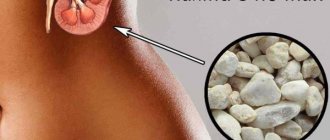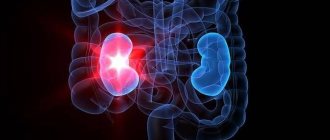Clinical picture
Symptoms of kidney disease in women are characteristic of one or another pathology. Some kidney diseases are asymptomatic. But if you feel unwell, experience nausea and shortness of breath, decrease in performance and weakness, it is recommended to consult a doctor.
The first symptoms of kidney disease in women are the appearance of swelling under the eyes and swelling of the legs. This disrupts the water balance. The amount of fluid excreted in urine exceeds the amount of water drunk. Some women may complain that they drink large amounts of fluid, but urinate infrequently and little.
Kidney disease may be accompanied by the distribution of fluid into the intercellular space. This contributes to the formation of edema of subcutaneous fat. A similar phenomenon is typical for the lower extremities, especially the feet. If signs of kidney disease increase, swelling increases. It can spread to the thighs, legs, face and neck. This clinic is more often observed in pregnant women or in cases where the patient spends a lot of time on her feet.
If a pregnant woman is on bed rest, then the liquid can be distributed as follows: the hands swell, then the face and torso. This explains the swelling of the face in the morning and the increase in symptoms in the legs in the evening.
If a kidney disease is accompanied by overhydration, then the swelling is symmetrical or positional. Sometimes overhydration occurs without visible swelling. In this case, the liquid is retained in the cavity spaces. Bags under the eyes are a clear symptom of kidney disease. At the same time, there is no swelling in other parts of the body, which is explained by increased hydrophilicity associated with heredity.
Prevention
To avoid kidney problems, women should monitor their fluid balance and drink enough fluids. It is recommended to take decoctions prepared from medicinal herbs that have a diuretic effect. It is important to control your diet; your daily diet should include healthy food filled with vitamins. A woman should lead an active lifestyle and perform special gymnastics.
The kidneys are often called a “silent” organ, probably because of their long-term tolerance. Even if the pathology is advanced, the only symptom that bothers you is a strange weakness. The full picture of the condition is revealed after blood biochemistry. Sometimes, along with its results, the patient receives a referral for hemodialysis. To prevent such a development of events, we will consider why the kidneys hurt, diagnostic and treatment methods, and preventive measures.
p, blockquote 1,0,0,0,0 —>
p, blockquote 2,0,0,0,0 —>
Backache
A frequent manifestation of kidney pathology is pain, which indicates the localization of the disease in this organ. Discomfort in the lower back may be a sign of the following kidney diseases: ureteral stricture, pyelonephritis, nephroptosis, polycystic disease, tumor, thrombosis.
If lower back pain is chronic, a comprehensive examination is required. The doctor must identify the mechanisms of occurrence of the syndrome. More often this is high pressure in the lumen of the urinary tract, which prevents the outflow of urine. In this case, urine begins to put more pressure on the walls of the ureter, where pain receptors are located. Then a signal is sent to the central nervous system.
Another cause of the syndrome is stretching of the organ capsule, which contains similar receptors. This phenomenon is associated with inflammation of the organ and overflow of the kidney with blood. Pain can manifest itself with different intensities:
- short-term discomfort;
- severe pain in the lower back;
- intense attacks.
In the latter case, psychomotor agitation is observed. The woman may moan in pain. Laboratory tests are indicated for differential diagnosis.
Diagnostics
If pain in the kidneys occurs, even if it is periodic, you should immediately consult a doctor and undergo a series of tests. Delaying the examination will lead to an exacerbation of the disease and a number of complications. First, the woman undergoes an examination by a gynecologist, who then prescribes the following tests:
- donating urine and blood for a general analysis, which will help identify the infection;
- ultrasound diagnostics of internal organs located in the pelvis.
In the absence of gynecological abnormalities, the woman is referred to a urologist. After this, it is recommended to undergo an x-ray examination of the internal organs. If necessary, urography is performed, in which the kidneys and organs of the urinary system are examined using a contrast agent. Additionally, computed tomography of the ureter and kidneys is performed.
Urine examination
Diagnostic signs of kidney disease are abnormal urine tests. If a woman sees red urine or sediment, consultation with a nephrologist is required. Normally, the color of urine ranges from clear to dark yellow. Urochromes, which are formed in the body, are responsible for yellowness. These pigments are excreted in the urine.
If their concentration is high, then the shade of urine is yellow and saturated. If the value is low, the color of the urine is light yellow or clear. The concentration is directly affected by the volume of urine excreted. If the value of the latter indicator is low, then the concentration of pigments increases. Urine takes on an intense hue.
Some kidney pathologies are accompanied by dark yellow urine. Such pathologies include jaundice and cirrhosis. Colorless urine is an early sign of chronic renal failure. This phenomenon is associated with a low concentration of excrement in the kidneys. In this case, a woman may complain of thirst, polydipsia and polyuria. Such a clinic is typical for diabetes, so a differential examination is carried out. If there is blood in the urine, you need to consult a nephrologist. Sometimes this is a sign of taking a chemical or medication. This condition is pseudohematuria.
More often, pseudohematuria is accompanied by hematuria. Red urine is due to red blood cells in the excrement. To identify a specific kidney pathology, a comprehensive laboratory test is performed. More often, such a clinic is observed with glomerulonephritis, urinary tract defects, urolithiasis and cancer. In this case, the study is carried out outside the menstrual period. Sometimes a urinary catheter is used or a tampon is inserted into the vagina.
Cloudy urine can be caused by the process of salt crystallization. If pus from leukocytes appears in the urine, the entire urinary system is examined. The result is influenced by leukocytes and bacteria that enter the sample from the vulva. Therefore, the collection of material is carried out in compliance with established rules.
Accurate diagnosis
At the first stage, the doctor interviews and examines the patient. Healthy kidneys cannot be palpated. With pathology, they themselves increase or this occurs due to the tumor. Changes are determined by the doctor by palpation and percussion. At the same time, the vagina is examined. Based on symptoms, determines the stage of the pathological condition. Among the instrumental methods used:
p, blockquote 30,0,0,0,0 —>
- Ultrasound.
- CT, MRI.
- Excretory urography to determine urinary tract patency and kidney activity.
To clarify the diagnosis, the patient donates blood to identify signs of inflammation, determine creatinine levels, and markers of infection. Based on the results of a urine test, we can talk about the functioning of natural filters. Urine culture provides information about the infectious and inflammatory process.
p, blockquote 31,0,0,0,0 —>
Increase in temperature and pressure
Rare manifestations of kidney disease include high fever. Normally, it should not exceed 37 °C. For the pathologies under consideration, it can fluctuate between 37.3-38.5 °C.
If a woman has a fever, which is accompanied by the symptoms described above, consultation with a nephrologist is required. Uncontrolled use of an antipyretic drug can adversely affect the patient's condition. High temperature associated with kidney disease indicates the patient’s adaptation to the process occurring in her body.
Fever disrupts the process of microbial reproduction, enhancing reparative and metabolic phenomena that stimulate the immune system. If pyelonephritis is present, then body temperature may exceed 38.5 °C. In such cases, it is recommended to take Paracetamol or Ibuprofen.
Kidney pathology and high blood pressure are interrelated phenomena. In 45% of cases, women with kidney disease have blood pressure that is abnormal. Hypertension is a persistent but long-term increase in blood pressure that can manifest itself. Sometimes hypertension develops against the background of chronic renal pathology. In such cases, hypertension is a secondary phenomenon and is considered nephrogenic symptoms.
Treatment
Drug therapy resists infections even with deep infection, supports the endocrine and immune systems as auxiliary mechanisms of action on the root cause of the disease.
p, blockquote 32,0,0,0,0 —>
Medicines
In addition to antibiotics, the use of uroantiseptics, such as Furagin and Monural, is indicated.
p, blockquote 33,0,0,0,0 —>
Herbal-based anti-inflammatory painkillers that remove stones have high healing properties:
p, blockquote 34,0,0,0,0 —>
- Canephron, including extracts of lovage, rosemary, rosehip and centaury.
- Phytolysin.
- Cystone, which removes phosphates.
Diuretic compounds are used to remove toxic waste products of pathogenic bacteria. Furosemide is a strong short-acting agent. It helps cope with severe edema and renal-type hypertension. Aldactone, Veroshpiron and other potassium-sparing diuretic drugs give good results.
p, blockquote 35,0,0,0,0 —>
To eliminate inflammation and relieve pain, use:
p, blockquote 36,0,0,1,0 —>
- Indomethacin.
- Ibuprofen.
- Diclofenac.
If the pain in the kidneys does not subside, use Baralgin and Metamizole. Treatment is carried out against the background of a special diet, in which there is no place for sweets, spicy, smoked, and salty foods. It is recommended to adhere to the drinking regime, give up alcohol and smoking. It is useful to strengthen the body with vitamin and mineral supplements.
p, blockquote 37,0,0,0,0 —>
Surgery
Surgery is indicated for congenital renal diseases, complications, tumors, and the presence of large stones. Benign tumors are removed, trying to preserve the organ; cancerous tumors are removed along with the kidney. If medications fail to dissolve the stones, they are crushed using contact or extracorporeal lithotripsy. Laparoscopic methods successfully cope with kidney stone disease. Coral stones and severe kidney damage are treated during open abdominal surgery. For renal failure, hemodialysis is indicated.
p, blockquote 38,0,0,0,0 —>
Folk remedies
Chamomile is a natural antiseptic. It will help with minor inflammation or at an early stage of pathology. It is used to prepare infusions and decoctions, with the help of which unpleasant symptoms are eliminated and toxins are removed.
p, blockquote 39,0,0,0,0 —>
Juniper berries in the form of alcohol tincture or dry powder also help in healing kidney tissue. By adding honey and parsley seeds to them, you can successfully dissolve small stones.
p, blockquote 40,0,0,0,0 —>
List of pathologies
The woman is diagnosed with the following renal pathologies:
- Pyelonephritis.
- Glomerulonephritis.
- Kidney failure.
- Nephrolithiasis.
- Hydronephrosis.
With the first pathology, the woman complains of high body temperature, severe sweating, lumbar pain, cloudy urine, and high ESR. The chronic course of the disease occurs without symptoms. A woman may complain of weakness, poor appetite, migraine.
Immuninflammatory pathologies of the kidneys include glomerulonephritis. The following symptoms indicate its course:
- slight excrement;
- swelling of the face;
- high blood pressure.
Against the background of impaired kidney function, acute renal failure develops, in which drowsiness, weakness, and the release of a small amount of urine are observed. If the disease proceeds without complications, then the woman will gradually recover. Nephrolithiasis is accompanied by the appearance of kidney stones. Pathology is more often diagnosed in women aged 25-50 years. At the same time, there is pus and blood in the urine, and the lower back hurts.
Atrophy of organ tissue associated with impaired urine passage is manifested by the following clinical picture:
- severe pain in the lower back;
- painful and frequent urination.
Unilateral hydronephrosis of the aseptic form occurs hidden. In this case, the woman drinks a lot of fluid.
Why do women get sick more often than men?
Kidney pathologies occur more often in the female half of humanity than in the stronger sex. The fact is that the anatomical structure of the female genitourinary system is significantly different from the male one .
In particular, a woman's urethra is much wider and shorter than a man's. This creates more opportunities for microorganisms. Through a wide channel they penetrate faster into the bladder and kidneys. Therefore, ladies are more often visitors to nephrologists.
Pregnancy also contributes to kidney dysfunction . During this period, the load on the organs doubles. Representatives of the fair sex who like to go on diets experience nephroptosis (increased kidney mobility). In men, this pathology is very rare.
Another difference between female kidney diseases is that they immediately manifest themselves with vivid symptoms : pain, pain when urinating, change in the color of urine. In men, many processes occur hidden, therefore the risk of the disease progressing to the chronic stage increases.
Abnormal organ development
Such deviations include nephroptosis, polycystic disease, dystopia, and cancer. With nephroptosis, pathological mobility of the organ is observed. In this case, its displacement by 2 cm vertically and by 3 cm during breathing is allowed. With this disease, a woman may complain of nagging pain in the abdomen. It goes away if the organ is back in place. Renal colic and digestive problems are allowed. Severe nephroptosis is accompanied by PN and urinary infection.
Polycystic kidney disease is a congenital anomaly characterized by the appearance of several cysts. The pathology involves 2 kidneys. In this case, the symptoms increase slowly. It is similar to chronic renal failure. The disturbed location of the kidneys is dystopia, which is considered a congenital pathology. The kidneys may be located low in the pelvic cavity or in the chest. In this case, there are no symptoms. Less common is dull pain in the lower back.
An organ tumor is a group of pathologies that are united by various cancerous transformations of renal tissue. Kidney cancer is detected in 2-3% of cases. More often the disease is diagnosed in women after 40 years of age. At an early stage there are no symptoms. Then the woman may complain of lower back pain, blood in the urine, or the appearance of a tumor (it can be easily palpated). Other manifestations of the malignant process:
- lack of appetite;
- swelling of the legs;
- dystrophy.
If any of the above symptoms occur, it is recommended to make an appointment with a nephrologist. Only he will be able to differentiate kidney diseases by making an accurate diagnosis.
Causes of sick kidneys
There are many reasons why kidneys hurt. In women, the main provoking factors are:
- Stay in the cold in light clothing.
- Pregnancy and childbirth.
- Food with a high protein content.
- Use of certain medications.
- Sexually transmitted infections.
- Diabetes.
- Hormonal disorders.
- Operations on the genitourinary system.
- Severe poisoning.
- Alcohol and drug use.
- Severe stress.
Diet food
Following a diet will help your recovery. The diet involves eliminating irritating dishes and products from the diet, and providing gentle treatment to damaged organs. Following a diet helps relieve inflammation and remove toxins.
Products to include on the menu
- Bakery products: yesterday's white yeast-free bread.
- During an exacerbation, meat is completely excluded for several days.
- First meal. Weak, not rich meat and fish broths (the first broth must be drained and cooked in the second). Vegetable broths and soups with added cereals. Milk soups. Cream soups.
- Second courses. Lean meat and fish are recommended to be steamed or boiled and consumed in limited quantities. Potatoes, mashed potatoes.
- Non-sour fruits are allowed: watermelons, melons, apricots, peaches, bananas.
- Salt can be 6-8 g per day.
- If you have kidney disease, you should not drink a lot of fluids. The drinking regime is determined by the doctor. Usually, in the absence of edema, it is recommended to drink 1.5-2 liters of clean drinking water. For some diseases, the drinking regime, on the contrary, is reduced.
- Boiled and fresh vegetables are allowed: pumpkin, potatoes, zucchini, beets.
- Fermented milk products: low-fat kefir, yogurt, cottage cheese.
- Beverages:
- weak black tea;
- herbal teas;
- diluted, non-acidic fruit drinks;
- compotes;
- juices
What foods to exclude when dieting
In case of exacerbation of kidney diseases, it is recommended to exclude from the diet:
- fatty, fried, smoked foods;
- pickles and marinades;
- alcohol;
- confectionery products with dyes;
- coffee and chocolate;
- spices.










